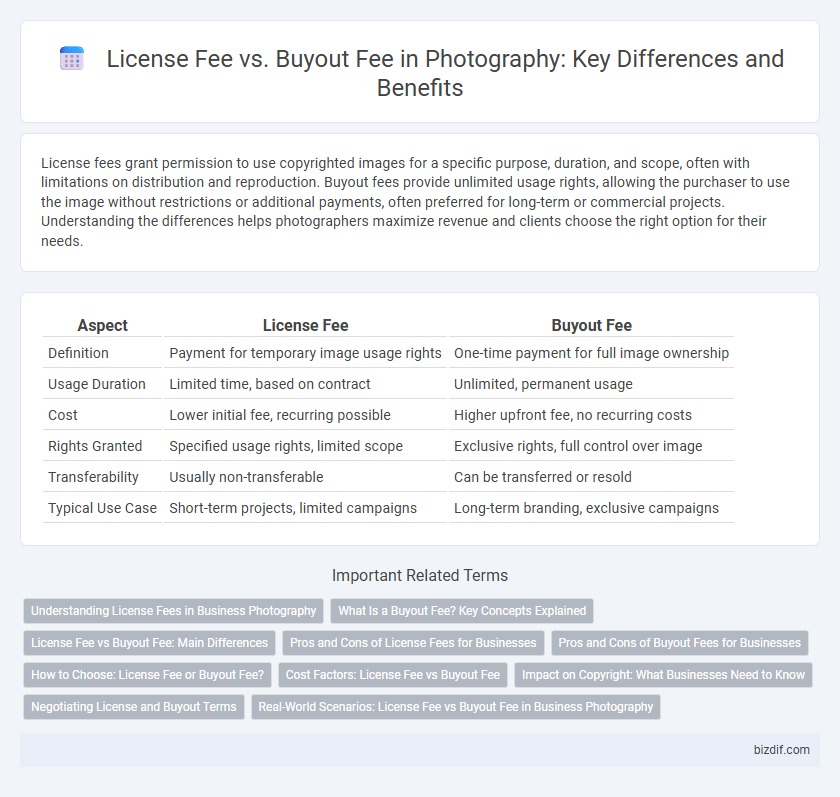License fees grant permission to use copyrighted images for a specific purpose, duration, and scope, often with limitations on distribution and reproduction. Buyout fees provide unlimited usage rights, allowing the purchaser to use the image without restrictions or additional payments, often preferred for long-term or commercial projects. Understanding the differences helps photographers maximize revenue and clients choose the right option for their needs.
Table of Comparison
| Aspect | License Fee | Buyout Fee |
|---|---|---|
| Definition | Payment for temporary image usage rights | One-time payment for full image ownership |
| Usage Duration | Limited time, based on contract | Unlimited, permanent usage |
| Cost | Lower initial fee, recurring possible | Higher upfront fee, no recurring costs |
| Rights Granted | Specified usage rights, limited scope | Exclusive rights, full control over image |
| Transferability | Usually non-transferable | Can be transferred or resold |
| Typical Use Case | Short-term projects, limited campaigns | Long-term branding, exclusive campaigns |
Understanding License Fees in Business Photography
License fees in business photography grant clients the right to use images for specified purposes and durations, typically calculated based on usage scope, distribution channels, and exclusivity. These fees provide ongoing revenue while maintaining the photographer's ownership rights, allowing flexibility for multiple clients or projects. Understanding license fees helps businesses budget accurately and ensures photographers are fairly compensated for the extent and impact of image usage.
What Is a Buyout Fee? Key Concepts Explained
A buyout fee in photography refers to a one-time payment granting the client unlimited rights to use an image without restrictions on time, geographic location, or media. Unlike a license fee, which typically limits usage by duration, platform, or scope, a buyout provides full ownership or extensive usage rights, eliminating the need for additional royalties. This fee structure is ideal for clients seeking indefinite and comprehensive control over photographic content.
License Fee vs Buyout Fee: Main Differences
License fees grant temporary rights to use a photograph under specific conditions, such as duration, medium, and geographic area, often involving recurring payments for extended use. Buyout fees involve a one-time payment that transfers full ownership or unlimited usage rights to the buyer, eliminating future licensing costs. Understanding these distinctions helps photographers and clients negotiate fair compensation based on usage scope and duration.
Pros and Cons of License Fees for Businesses
License fees offer businesses flexible usage rights for photographs without the commitment of full ownership, allowing cost-effective access to high-quality images for specific projects. These fees enable control over usage scope and duration, reducing upfront costs compared to buyouts, but may entail recurring expenses and restrictions on extended or exclusive use. Businesses benefit from scalability and lower initial investment, while facing potential limitations on long-term content control and the need to renegotiate fees for expanded rights.
Pros and Cons of Buyout Fees for Businesses
Buyout fees provide businesses with unlimited usage rights for photography, eliminating recurring license fee payments and simplifying budgeting. This one-time fee grants full control over images, enhancing marketing flexibility and reducing legal complexities related to usage restrictions. However, buyout fees often require a higher upfront investment, which may be cost-prohibitive for small businesses with limited budgets or short-term campaigns.
How to Choose: License Fee or Buyout Fee?
Choosing between a license fee and a buyout fee depends on the intended usage and duration of the photography rights. License fees are ideal for limited, specific uses with clearly defined terms, offering flexibility and lower initial costs. Buyout fees provide unlimited, perpetual usage rights, making them cost-effective for extensive or long-term projects where ongoing royalties would be impractical.
Cost Factors: License Fee vs Buyout Fee
License fees typically involve recurring payments based on usage duration or distribution scale, making them cost-effective for limited or specific projects. Buyout fees require a one-time payment granting extensive or perpetual rights, often resulting in higher upfront costs but eliminating future licensing expenses. Choosing between these depends on budget constraints and long-term usage plans, with license fees favoring short-term needs and buyout fees benefiting ongoing or broad applications.
Impact on Copyright: What Businesses Need to Know
License fees grant businesses temporary rights to use copyrighted photography under specific terms, preserving the photographer's ownership and control over the image. Buyout fees transfer full ownership rights, eliminating ongoing royalties but requiring a higher upfront payment and relinquishing the photographer's control. Understanding the impact on copyright is crucial for businesses to balance cost, usage flexibility, and legal protections.
Negotiating License and Buyout Terms
Negotiating license and buyout terms requires a clear understanding of usage rights and budget constraints, as license fees typically cover limited time or scope, while buyout fees grant more extensive or exclusive rights. Photographers should specify usage duration, geographic reach, and media types to accurately determine fees and avoid future disputes. Detailed contracts outlining these terms ensure mutual agreement and protect both parties' interests in photography licensing deals.
Real-World Scenarios: License Fee vs Buyout Fee in Business Photography
In business photography, a license fee allows clients to use images for specific purposes and durations, typically making it cost-effective for short-term campaigns or limited usage such as websites or social media. Buyout fees grant extensive or unlimited usage rights, ideal for long-term branding efforts or exclusive ownership scenarios, often involving higher upfront costs. Understanding the distinctions helps businesses optimize budget allocation while ensuring proper image rights management for commercial use.
License Fee vs Buyout Fee Infographic

 bizdif.com
bizdif.com